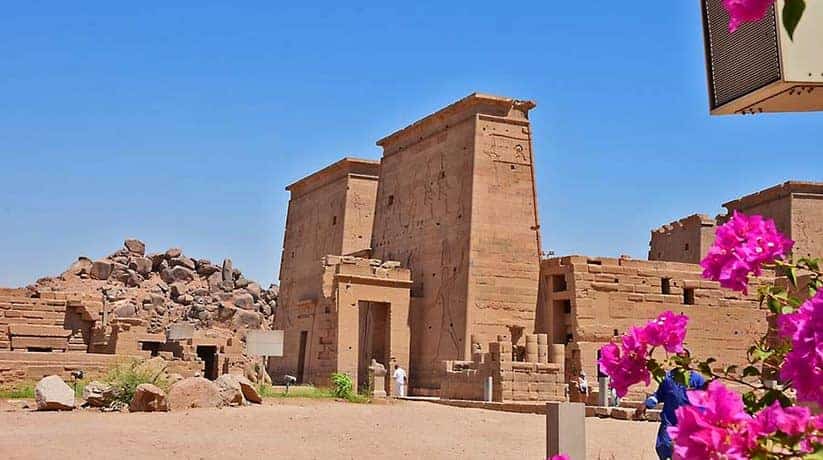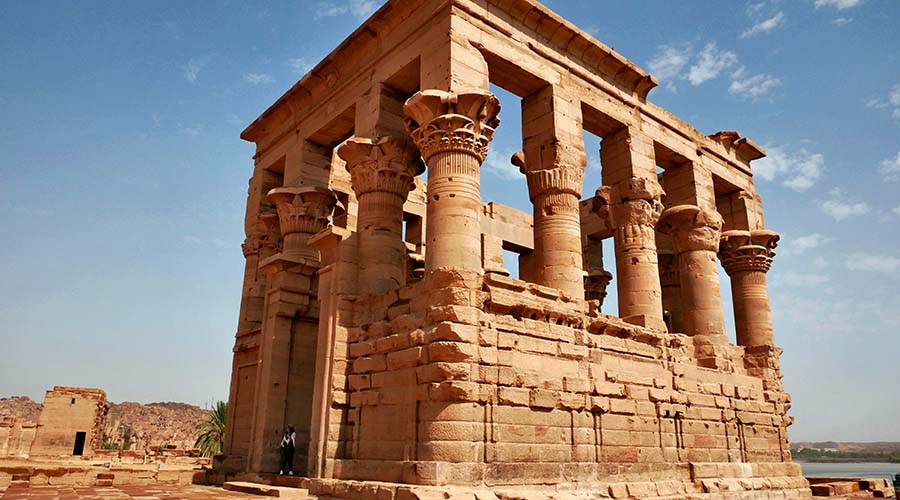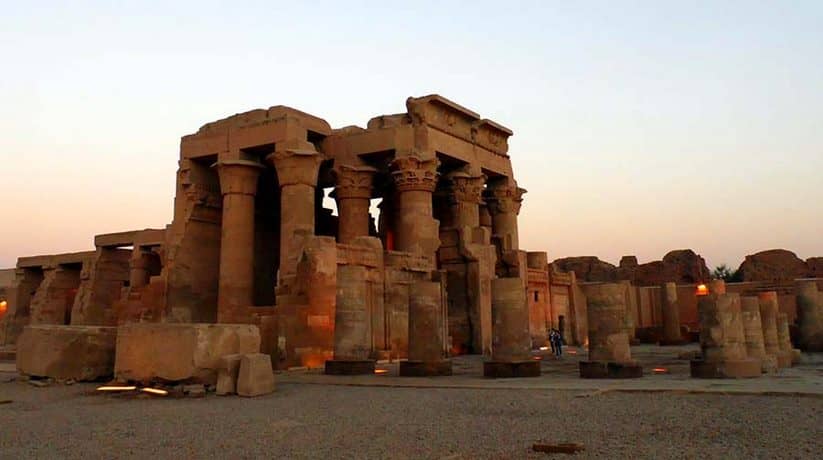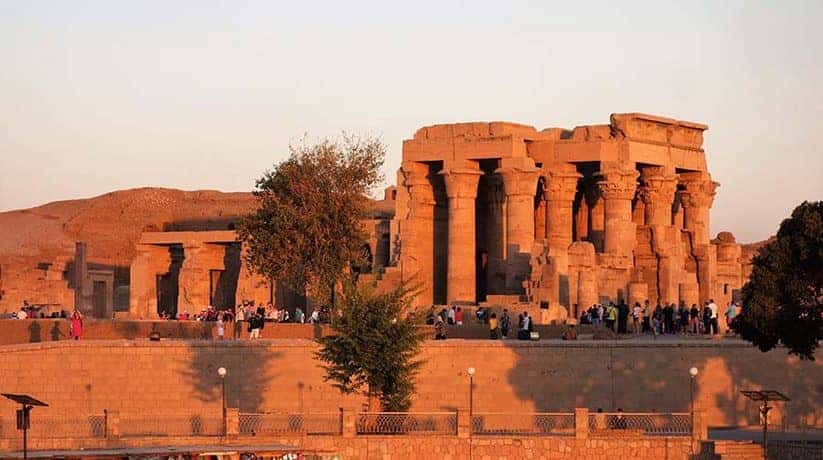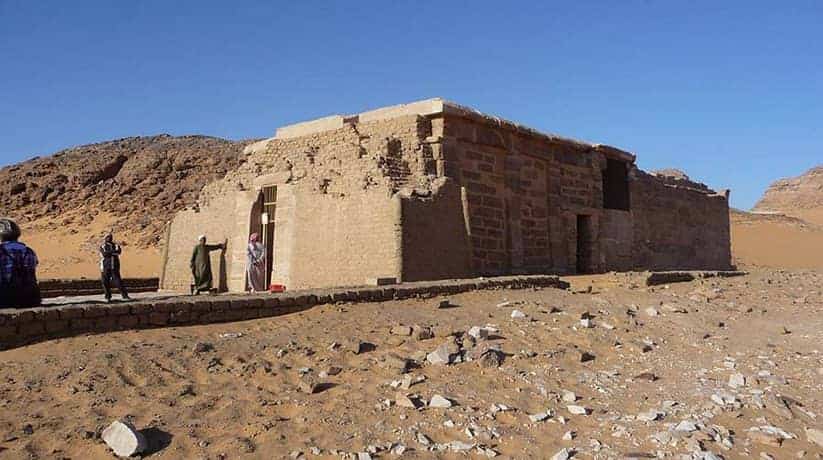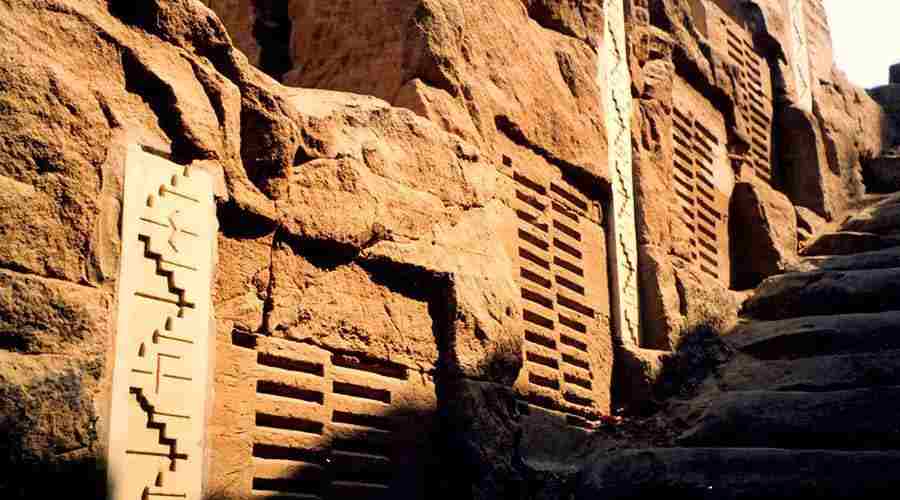Ancient Aswan sites, tours, booking, prices, reviews
Ancient Aswan include Amada temple which located about 180 kilometers south of Aswan High Dam. In fact, Amada temple dedicated to the New Kingdom gods, Amun-Re and Re-Horakhty. The temple built on the orders of Thutmose III and his son, Amenhotep II. It was during Egypt’s New Kingdom 18th Dynasty. The hypo-style hall was a later addition by Thutmose IV. In fact, Seti I had a hand in some small additions such as a large pylon. The pylon is with a sandstone gateway abutting against the hypo-style hall. It is along with other 19th Dynasty rulers including his son, Ramses II. Ramses II involved himself in some way with almost every Nubian temple built before his reign. However, Ramses II’s restoration of the temple noted as rather a poor effort.
Ancient Aswan also include include Aswan Nilometer which located at Elephantine Island in Aswan. In fact, Aswan Nilometer has a greater importance more than showed in most of books about Egypt. Egypt has four Nilometers on the Nile for measurements of the level of water. In fact, Aswan Nilometer which located at the first Cataract of the Nile, was prime. It was the earliest warning of fluctuations in the River’s depth. The changes of water level recorded and published. This information used to predict silt levels and thus manage the agriculture. The agriculture was completely dependent on the flooding levels of the Nile River. Taxes based on the amount of flooding received up until the middle of the 20th century. Aswan Nilometer is one of the most intact relics of Elephantine Island. In fact, it was an instrument which kept in a state of repair to be useful.
Further details about Aswan:
Ancient Aswan also include Dakka temple which is a Greek-Roman temple and known also as el Dekka temple. The temple dedicated to Thoth of the Sycamore Fig, the god of wisdom. In fact, the temple located about 100 kilometers south of the Aswan High Dam. The south of Aswan High dam referred today as Nubia. Though much of that ancient land covered by Lake Nasser. The temple known to the Egyptians as Pselqet and to the Greeks as Pselchis. In fact, the temple moved to the site of wdi es-Sebua. The site is about 40 kilometers upstream, between 1962 and 1968. It was because of the impending flooding of the region as a result of the High dam. The temple which we see today actually begun by the Nubian king, Akamani. The Greeks called him Ergamenes in about 220 BC. The temple construction appears to be a combined effort.
Ancient Aswan also include El Derr temple which located 280 kilometer south of Aswan, Egypt. In fact, the temple is Nubian temple which hewn out of the rock. Moreover, the temple dismantled in 1964 to save it from the waters of Lake Nasser. It was after the construction of Aswan High Dam. El Derr temple Aswan moved to a new location which is close to Amada temple. The temple built during the 30 years of Ramses II reign. It was to celebrate his Sed festival. In fact, the temple is similar in many respects to his other Speos style monuments in Nubia. In fact, some of the temple’s decorations lost due to its use as a church by early Christians. However, many scenes remain at the temple. The scenes include one which depicts a procession of Ramses II children with girls on one side of the temple.
More details about Aswan:
Ancient Aswan also include also include Kiosk of Qertassi. It is a tiny Roman kiosk which located south Kalabsha temple. In fact, the Kiosk has four slender papyrus columns inside. It also has two Hathor columns at the entrance. In fact, Kiosk of Qertassi Aswan is a small but indeed elegant. The structure unfinished and not inscribed with the name of the architect. It probably is contemporary with Trajan’s Kiosk at Philae. The Kiosk of Qertassi Aswan dates back to the Augustan or early Roman period. The structure is only twenty-five feet square, and consists of a single Hathor court. It oriented north or south and surrounded by fourteen columns connected by screen walls. Of the 14 pillars, only 6 have survived in place. The pillars or columns made of brown sandstone.
Ancient Aswan also include Kalabsha temple. In fact, it is a Nubian temple which located south of Aswan. In fact, the temple was a part of the rescue operation for monuments which threatened by waters of Lake Nasser. Kalabsha temple Aswan transported to the present site courtesy of the German Federal Republic. It was in a salvage operation which sponsored by UNESCO in the 1960. The temple original position was 56 km south of Aswan. It was until it dismantled and moved to the island which now called New Kalabsha. The island is just south of the Aswan High Dam. It seen from the Dam through a good pair of binoculars. The temple built over an earlier New Kingdom site. It was during the Roman Period for Caesar Augustus. In fact, the temple dedicated to Isis, Osiris and Horus-Mandulis.
Further details about Ancient Aswan:
Ancient Aswan also include Kom Ombo temple which located in the town of Kom Ombo. In fact, the town is an industrial town 45 km north of Aswan. Its classical name was Ombos and its ancient name is Nebet. It placed between Edfu and Aswan as a garrison town on an important trading route. The Ptolemaic temple and ancient town site is a few kilometers from the modern town. It is on a promontory on the east bank of the Nile. In fact, Kom Ombo temple Aswan indeed is unusual. It dedicated to two triads of deities. Each with its own associated chambers and sanctuaries. Moreover, on the eastern side of the temple, the crocodile god Sobek honored with his wife. The wife here named as Hathor and their son Khonsu.
Ancient Aswan also include Meharakka temple which built under Roman rule. In fact, the temple not finished. Meharakka temple Aswan indeed is special. It is because it has the only spiral staircase in any ancient Egyptian structure. The temple dedicated to Serapis, the Alexandrian god. This god introduced in Egypt in Ptolemaic times. The god is a fusion of the Egyptian Gods Osiris, Apis, the Greek gods Zeus and Aesculape. In fact, Al-Meharakka is a place in Lower Nubia which was approximately 120 km south of Aswan. It was on the southern border of the Roman empire. The Kushites from the kingdom of Meroe launched a raid on the First cataract region of Egypt in 23 BC. It was only a few years after the Roman conquest of Egypt in 30 BC.
More details about Ancient Aswan:
Ancient Aswan also include the Nubian museum. In fact, the museum designed by Mahmoud Al Hakim. He created the Nubian museum building in harmony with the surroundings. In fact, the surroundings include huge rocks, small mountains and the shining sun of Aswan. The Museum opened in 1997. The beautiful lines of its architecture are worth to see. The museum nestled into the hillside. It covers 50,000 square meters of landscaped gardens and buildings. The gardens and buildings divided up into different sections. The museum indeed is a gateway in the history of Nubia. It lets visitors understand the complex history of this unique area. In the museum, each exhibit has a description note underneath it. In fact, it written in Arabic and English languages.
Ancient Aswan also include Penout tomb. In fact, the tomb belongs to Penout who was once a Viceroy of Kush. It was during the reign of Ramses IV (12th century BC). The tomb of Pennout has carvings on the wall in which Ramses IV honors his civil servant. In fact, the tomb located in Aniba, an area which was the home to many tombs. Penout was also a priest of Horus, that is why his tomb is fine and contains its own altar. The statues which once stood on it are now missing. Moreover, the tomb also features large sections. The sections containing inscriptions, carvings, and many high quality paintings. In fact, the tomb itself robbed and no sign of Penout’s mummy ever found. Furthermore, Penout was a governor of Lower Nubia and was Nubian as well.
Further details about Aswan:
Ancient Aswan also include Philae temple which located 12 kilometers south of Aswan. In fact, the temple was an ancient pilgrimage center for the cult of Isis. It also was for the dazzled travelers with its power for centuries. Philae temple Aswan is sacred site. It venerated from the Pharaonic era up to the Greek, Roman and Byzantine periods. In these periods, each ruler added his own stamp onto the stones here. The First Pylon at Philae temple Aswan, leads into the main temple area. In fact, the temple features two towers and central doorway. Both of them provide a grand 18 meter high entry. The entry with reliefs by Nectanebo. Moreover, there is a doorway in the western tower with reliefs by Philometor. It leads to the Birth House.
Ancient Aswan also include Qasr Ibrim which stood on the highest of three headlands one day. It was on the east bank of the Nile some 70 meters above the River in Aswan, Egypt. In fact, it was before the construction of the High Dam south of Aswan. Today, Qasr Ibrim is the last on Lake Nasser before reaching Abu Simbel. Visitors may only gaze upon it from the Lake Nasser Cruise boat. In fact, Qasr Ibrim is no longer accessible by tourists. However, the Egypt Exploration Society does continue the work on the site. The work is since 1959. In fact, Qasr is an Arabic word which means fort. So, the Fort of Ibrim is the English translation of Qasr Ibrim. The name derived from its ancient Meroitic name, Pedeme. In classical texts, it called Primis. Moreover, in Coptic called Phrim which corrupted to Ibrim in Arabic.
More details about Aswan:
Ancient Aswan also include Satis temple which located at Elephantine Island and also known as Satet temple. In fact, Satis was the consort of Khnum. Satis temple Aswan consists of several rooms and a surrounding gallery. The entrance located to the right of the front facade of the temple. It communicates with a large hall with two pillars that decorated with Hathor heads. Within this hall, there is a doorway on the northern rear wall. It leads to a chapel dedicated to Amun. Moreover, Satis temple Aswan has a door on the left of the rear wall. In fact, this door leads to other rooms. The newest, reconstructed temple has carved and painted stone blocks. They show Thutmose III in front of various members of the Elephantine triad. In some areas the original blocks missed.
Ancient Aswan also include the tombs of the Nobles which located near the West Bank of Aswan. In fact, they are in front of the Northern section of the Elephantine Island. The tombs of the Nobles indeed have a significant importance. The tombs chance to know about the history of Egypt during the Old and the Middle Kingdoms. Lord Greenville was a British archaeologist. In fact, he was the one who discovered the tombs of the Nobles Aswan. It was in the period between 1885 AC and 1886 AC. In fact, the tombs of the Nobles located in area which called the tombs of Kubbet El Hawa. This area has some wonderful ancient art. It also has a noteworthy chronological importance of the Middle and the Old Kingdoms.
Further details about Ancient Aswan:
Ancient Aswan also include the Unfinished Obelisk which located in the southern end of Aswan town. In fact, the Unfinished Obelisk still remains in situ and attached to the rock on one side. The southern end of Aswan town was an area of ancient granite quarries. It is where the most valuable stone for the building of many of Egypt’s monuments obtained. Most of tour packages in Aswan include the visit of the Unfinished Obelisk Aswan. In fact, it situated in the northern part of the quarries. It indeed is gigantic single piece of granite. The Unfinished Obelisk in Aswan intended to be an obelisk which attributed to Queen Hatshepsut. In fact, it is like her obelisk in Karnak temple in Luxor. Some fine reliefs depict the transportation methods of an obelisk. You can see these reliefs in Hatshepsut temple.
Ancient Aswan also include Wadi Es Sebua temple which located about 140 kilometers south of the Aswan High Dam. It located in ancient Nubia on the west bank of the Nile. In fact, two temples built during the New Kingdom’s 18th and 19th Dynasties. One of these temples built by Ramses II and it now referred to as the temple of Wadi es-Sebua. In fact, it known as the “House of Amun”. Wadi Es Sebua temple Aswan salvaged in 1964 and moved to a new elevated site. The site is several kilometers to the northwest. It was after the construction of Aswan High Dam. The second temple which built by Amenhotep III, buried beneath the waters of Lake Nasser. However, five stela from this temple are in the Aswan Museum.

